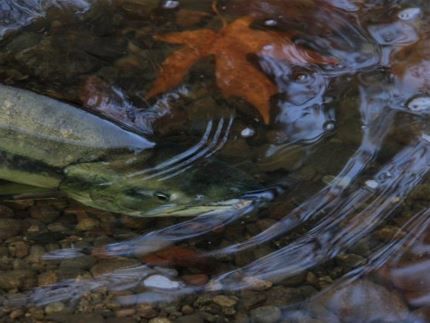
(Photo Courtesy Joe Foy)
Looking back through the years I have worked on salmon projects around the west coast of Canada I realize that one species, chum salmon, has engaged my imagination much, much, more than the other salmon species.
Why would that be when my very earliest experiences with salmon come from the coho salmon in the neighbourhood streams? Summer coho fry to be chased or caught as a child or a silver bright in the ocean and rivers as an angler as I grew older.
Chinook salmon to me were always the King of Salmon, Kos, Sachem, or Tyee, the ultimate angling trophy for a teenager trolling a line off Campbell River, dreaming of the “Big One”.
Pink salmon, humpbacks or just humpies came in such abundance they covered rivers more like the rocks along its bed, so numerous they were hard to count, but somehow almost not seen as individual salmon in their massed glory.
Sockeye salmon were the species everyone wanted to have over for dinner, the money fish for the net fisherman, summer abundance in the larger rivers heading for lakes far upstream, but so iconic they seemed almost like a movie star that was admired but someone you never really got to know at a deeper level.
We are left with the last local Pacific salmon, the often-overlooked chum (keta) salmon.
As I heard many times growing up, Dog Salmon, not great on the plate, sometimes nuisance abundance, that got in the way of catching those lovely, bright, coho salmon from a full and lively October river
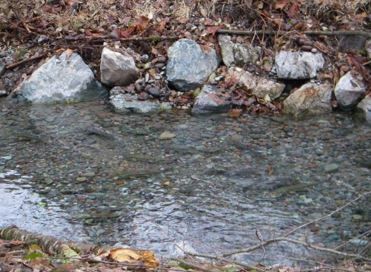
Spawning chum salmon in constructed groundwater spawning channel Squamish, BC, Canada..
But at the end of the day when I look back over the last forty years of working on salmon restoration projects across the west coast and now recently in far off places, it is always chum salmon that has led me to experiences and places I could not have imagined.
Unique places with complex and mysterious geology, itself a legacy of times long past, before, during and after the advance, retreat and advance of the continental glaciers over time scales beyond my imagination. To places where ancient cultures understood the role this species played in providing for their families, for keeping them alive during the long, dark days of the northern winters. To places that still have great seasonal migrations of wildlife that follow rhythms composed over millennia and continue to inspire.
Chum salmon, to me represent the mother salmon, the protector of life. Perhaps taken for granted, but ultimately the species, that allowed for life and health and happiness of many first peoples and the wildlife of their worlds, where ever chum salmon were found in abundance across the great north arc of the Pacific Ocean.
My first professional experience with chum salmon occurred in 1980 when I began working for the Fisheries and Oceans Canada (DFO), Salmonid Enhancement Program (SEP). I worked with a group called the “Small Projects Unit” who at the time were developing semi-natural techniques for restoring and enhancing salmon habitats.
One my early mentors was Dave Marshall, a DFO Senior Biologist, who had worked on stream improvement projects throughout the Georgia Basin and as a young biologist, had worked on the assessment of the then severely depressed Fraser River chum salmon populations. It was during those years he learned to respect and understand the importance of chum salmon.
Dave, working with Rheal Finnigan, SEP Senior Engineer, were the first to develop a technique known as constructed groundwater fed spawning channels. Both these guys took on this challenge with a passion that was infectious and has stayed with me since those early days.
From these two characters I was first introduced to the magic of upwelling waters from the earth and the chum salmon that would seek out these special places.
This stream restoration work took me to the groundwater rich waters along the Harrison, Squamish, and Chilliwack-Vedder Rivers and Norrish Creek in the south-west BC.
Bob Brown, SEP Senior Technician who gave me my first practical experience assessing and studying these unique groundwater chum salmon spawning areas and helped me to develop a deeper appreciation and understanding how very special these places were.
His stories of his time as a young technician up in the far north along the Yukon River, including a mysterious place called the “Fishing Branch River” mesmerized me then and now. A place where old cultures relied on the caribou and chum salmon above the Arctic circle to make it through the long polar winters.
Later, I was involved in technical exchanges with our American colleagues, who were also working on chum salmon groundwater spawning habitat enhancement on Herman Creek, a tributary of the Chilkat River, near the town of Haines Alaska. Three groundwater spawning channels were ultimately built and are now maintained by the Northern Southeast Regional Aquaculture Association, who’s mission was to enhance salmon stocks in this region of Alaska.
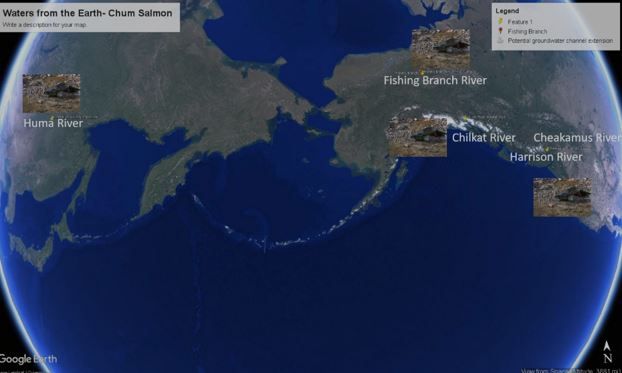
During one visit, I had the pleasure to tour and explore the groundwater and chum salmon rich waters of the Chilkat River in south-eastern Alaska. This special watershed has been coveted by the Tlinglit peoples for generations. It continues to be a celebration of chum salmon and the wildlife that comes to those shores each fall and winter to feed during that starvation time of the year.
Finally, after retiring from DFO I have had the freedom to follow my interest in chum salmon wherever they call me. Recently while volunteering for an organization in China, who are working hard to restore their great chum salmon legacy, I have been taken to places, such as the Huma River, and experienced other salmon cultures that I could not have imagined so many years ago when I was first captured by this species. I am in awe of the impact this fish has made on both the people and wildlife along the salmon streams around the Pacific Rim.
So, in this Chinese “Year of the Dog” and this “International Year of the Salmon” I hope I can convince you to think a little kindlier toward this under- appreciated Pacific salmon the chum salmon, in this, my “Year of the “Dog Salmon”.
Pure spring water and chum salmon- Tenderfoot Creek, Squamish BC, Canada
Photo: Courtesy Bob Turner
There has always been something magical about water flowing up out of the earth. Gently flowing out of the ground, natural spring areas or groundwater upwellings have always been considered special and sacred places by human cultures around the world.
Aquifers, springs, rivers and wetlands are naturally connected. Rain falling down onto the surrounding areas can find its way deep into the ground, passing through areas of fractured rock or porous materials laid down by erosion, rivers or glaciers.
Minor springs occur everywhere this groundwater flow meets an obstacle and breaks out at the surface along a rivers bed or floodplain. Around the northern coasts of the Pacific Ocean, the latest timed runs of chum salmon (Oncorhynchus keta), are tightly bound to these waters from the earth. In cold, far north or interior rivers, winter flows can be almost totally dependent on these groundwater sources. Where groundwater upwells from below it is generally warmer than the surrounding waters during the cold time of year.
Chum salmon seek out these special places to build their redds and lay their eggs, thereby protecting them from the harsh freezing conditions of these cold environments.
In more turbulent coastal streams of the south, where winter storms driven by warm Pacific rains falling on snowpack, chum salmon will often seek out the very edges of river floodplains, in side channels and sloughs that contain upwelling groundwater.
These areas are semi-protected from the worst of the scouring floods of the main channels but may become disconnected from direct river flows as the winter progresses and as air temperatures and river flows drop. Redds in these areas remain safely tucked away from the high turbidity and silt loads present during these wild and wet Pacific storms. During the low, cold flows of winter as they are sustained by the consistent, filtered upwelling groundwater flow past the developing eggs and embryos.
The richest groundwater upwelling zones in rivers often support the most abundant chum salmon populations. Chum salmon in these warm upwelling flows spawn much later than would be expected as their eggs exist in a world heated by the earth itself and not tied to the whims of the season, climate or local conditions. These rich chum salmon oases’ have supported both people and wildlife for millennia.
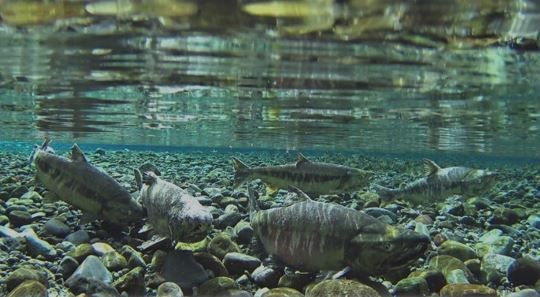
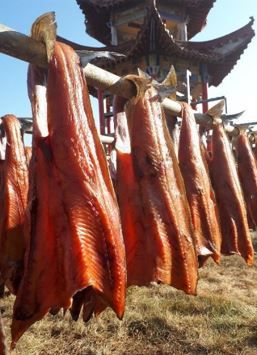
Wind dried chum salmon, Heilongjiang Province, China
Chum salmon in the upper Amur River, also known as the Heilongjiang (Black Dragon) River in China are the longest migrating chum salmon in the world. Upper Heilongjiang River chum salmon migrated up to 3000 kilometers from the ocean to spawn as late as November in tributaries such as the Fabiela, Erdao, Kuanhe, Yangjiao, Huma, Xi’ergenqi, Pangu and Emu’er.
Chum salmon were an historically abundant species in northeast China and also important as a local food source during winter time for both people and wildlife. Unfortunately, this species is close to being extirpated from China streams within the Heilongjiang and other China watersheds.
The great Amur/Heilongjiang watershed is shared between three countries, China, Russia and Mongolia and was once the greatest chum salmon producing river in the world. Early estimates place chum salmon returns to this watershed in excess of 30 million per year.
Today these chum salmon returns have declined to 10-30 % of those levels that existed before the arrival of extensive commercial fisheries beginning in the early twentieth century.
The delta of the Huma River, rich in upwelling groundwater, where it joins the upper Heilongjiang River, some 2000 kilometers upstream from the Sea of Okhotsk, is a good example of one such upriver chum salmon spawning ground.
The lower Huma River’s many flowing groundwater side channels that refuse to freeze during the long winter months, supported abundant runs of chum salmon late into the fall as recently as the 1960’s. For untold generations the local Oroqen people (People of the Reindeer) would have relied on these late fall salmon runs for a part of their winter food supply.
As the last Huma River chum salmon finish building their redds near upwelling groundwater, the cold north winds from the Siberian taiga have already begun freezing the big rivers flows.
These runs of chum salmon, in such a harsh interior environment, only existed because of these warm water refuges but their continued existence today is threatened by overfishing and other impacts
Upper Heilongjiang (Amur) River, Huma City, China, October 2017
Today there is a debate on whether or not there are any Huma River chum salmon still returning to spawn in this 200- kilometer long river. They have not been seen by local fishermen for many years and this is also the case for the many of the spawning streams along the upper third of the large Heilongjiang watershed. Industrial developments, hydro-electric dams and especially over-fishing in the lower Heilongjiang has led to this conservation concern.
Today there is an awakening in China and a better understanding of how important chum salmon have been to the human cultures of northeast China.
Questions are being raised on how to best take actions to conserve what chum salmon legacy remains in China.
An active program for the restoration of chum salmon in China is being led by a Chinese NGO, Salmon Ecological Environment Protection Association (SEEPA) of Fuyuan County, Heilongjiang Province.
SEEPA was founded in 2015 and has been financially supported by the “Forever Nature Capital Foundation” (FNCN), formed in 2016, under the sponsorship of a group of China entrepreneurs (http://www.dmhrun.com).
Jim, Tianhang, Jiaying, Xin, Yuechan and Ruirui and many, many others dream that after a long winter of decline a new spring will arrive and chum salmon will once again thrive in China within the great Heilongjiang watershed.
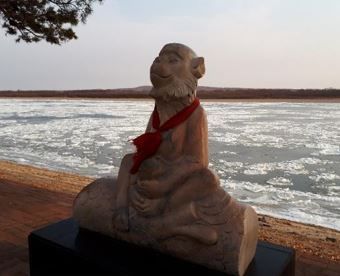
Jim, Tianhang, Jiaying, Xin, Yuechan and Ruirui and many, many others dream that after a long winter of decline a new spring will arrive and chum salmon will once again thrive in China within the great Heilongjiang watershed.
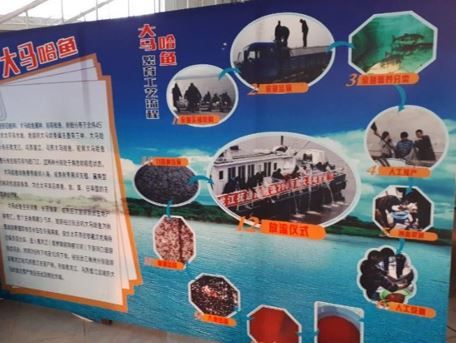
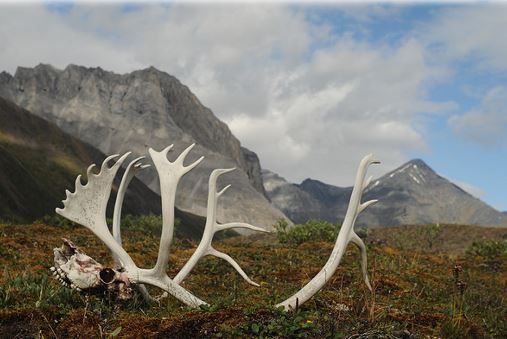
Caribou Remains Photo: Courtesy National Parks Service, Alaska
Sergeant W.J.D. Dempster, of the North West Mounted Police, wrote to his Commanding Officer in Dawson (February 11, 1917) about his travels to this special place.
"...reach[ed] the Fisher (sic.) Branch of the Porcupine River...and is so called on account of its being a great spawning ground for the salmon, more especially the dog-salmon; [a] short distance above the stream from where we reach [ed] it, the Indians claim the river never freezes, and this I believe is true, as I saw a thick fog hanging over, and this always means open water in winter. There are also large numbers of dead salmon in the water and on the beach, and this attracts numbers of wolves who feed off the dead fish".
These warm, constantly flowing, waters emerge from deep under Bear Cave Mountain, to support this unique chum salmon refuge. Flowing waters during the winter cold, that may have fallen as rain years before, flow along ancient paths through the heart of this mountain. These subterranean passageways, which were formed by acidic waters as they passed through fissures in the calcium rich, marine limestone bones of the mountain. Remains of hard shelled animals and ancient tropical reefs, warms water as it flows down from northern rain and snow above, to emerge upward into the long and cold polar night. These waters from the earth have nurtured chum salmon, people and all the other wildlife in this northern oasis for time out of mind.
For countless generations, the Vuntut Gwitchin (People of the Lakes) have lived in the Old Crow Flats and Porcupine River areas in the northern Yukon and the (Fishing Branch) was well known to them. http://oldcrow.ca/index2.htm. While the Porcupine caribou herd and an abundance of fish, plants and wildlife in the Old Crow Flats provided sustenance for the Gwitchin throughout the year, the Fishing Branch was a special place that salmon and other fish could be taken, if needed, throughout the long northern winters.
Known as the “River Where Salmon Spawn” Gwitchin elders regard this area as a source of life where ecological interactions must not be disturbed. Science in 1971 finally caught up to what had been known for centuries. Mike Elson with the assistance of Chuck Walker of the then Fisheries and Marine Service Canada and many others, undertook the first biological surveys of this now world-renowned chum salmon spawning stream. http://www.dfo-mpo.gc.ca/Library/20401.pdf
To the Vuntut Gwitchin, the protection of the Fishing Branch River was of paramount importance and in the year 2000, the Ni’iinli (Fishing Branch) Ecological Reserve was signed off by the Vuntut Gwitchin First Nation and the Yukon Government to protect this priceless natural heritage. http://www.env.gov.yk.ca/camping-parks/FishingBranch.php
In both these cold interior rivers, the Amur and the Yukon, the presence of upwelling groundwater that support chum salmon so far from their ocean haunts have created rich salmon oases’ where none should exist. Other groundwater rich, chum salmon habitats, wherever they are found around the Pacific Rim, have always supported complex communities of life and culture.
Tlingit Salmon Trap
Photo: Courtesy Sheldon Museum and Cultural Center, Haines Alaska
The Chilkat River in Southeast Alaska, lies approximately 800 kilometers to the south of the Fishing Branch River and is another place that geology and biology have conspired to create a place of special significance. Home to the Chilkat Tlingit people who now reside primarily in Klukwan (the Eternal Village) on the banks of this salmon rich river. http://chilkatindianvillage.org/traditional-knowledge-camps
Chilkat oral history records their lineage was founded generations ago by Gaanaxteidi (Raven Clan) men and their Kaagwaantaan (Eagle Clan) wives who found this area to their liking due to its rich natural resources. The Chilkat people have coveted this river valley because of its salmon abundances and in particular for its late runs of chum salmon.
The Chilkat River is perhaps most famous to the outside world because of the dense populations of the iconic bald eagle that there are found each winter. The Bald Eagle (Haliaeetus leucocephalus) of the north-eastern Pacific shores migrates great distances in the summer and fall to access the abundant salmon runs of western North America.
By late fall, when most of the regions salmon runs are long gone, the chum salmon are just getting started in certain places blessed by waters from the earth. Bald eagles are attracted to the river "flats" of the Chilkat River by the availability of spawned-out chum salmon. Chum salmon escapements can exceed 300,000 spawners in some years.
Even during severe winters, the discharge of a near surface aquifer held within the deep alluvial gravels, at the junction of the Tsirku, Kleheni, and Chilkat Rivers, can result in up to 8-kilometers of open waters. This combination of open water and large amounts of chum salmon carcasses in late fall-winter can sustain these high concentrations of eagles in the Chilkat Valley, through February.
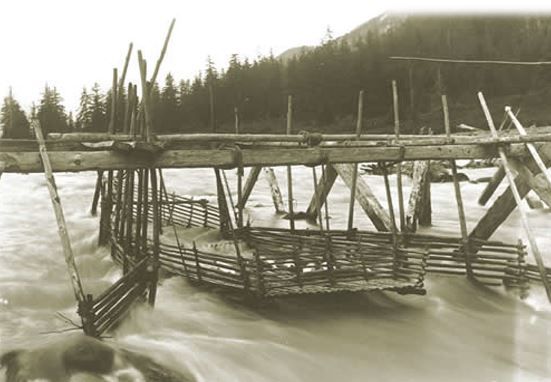
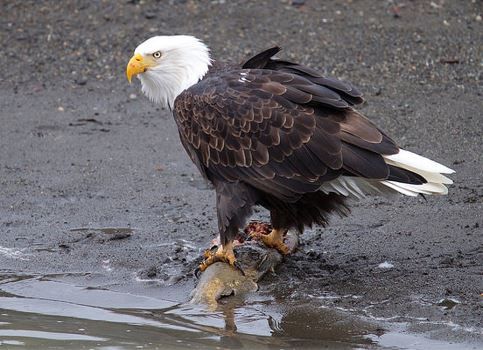
Bald Eagle (Haliaeetus leucocephalus) and chum salmon
Photo: Courtesy Jerry McFarland
The Chilkat Bald Eagle Preserve, near Haines Alaska was created in 1982 to protect what was then the world's largest known concentration of bald eagles. Single day counts approached 3000 birds in some years. http://dnr.alaska.gov/parks/units/eagleprv.htm
This watershed is one link in a chain of groundwater rich chum salmon oases that stretch south from the Fishing Branch River, Yukon, to the Chilkat River, Alaska and then down the Pacific Coast to rivers such as the Nooksack River in Washington State.
For eagle lovers, all these chum salmon oases are a life experience to visit but two BC watersheds, the Squamish and Harrison Rivers, are truly in a class of their own.
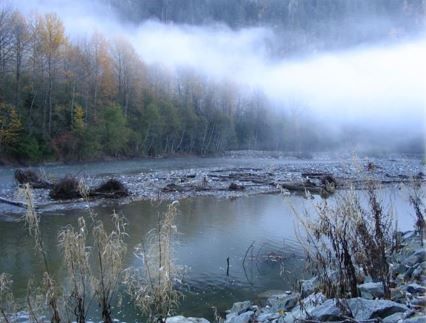
Cheakamus River, Squamish, BC, Canada
Another 1300 kilometers south of the Chilkat River, lies the Squamish River watershed set in the rugged terrain of the British Columbia Coast mountains. Squamish, and its major tributaries the Cheakamus, and Mamquam Rivers, have prolific runs of late spawning chum salmon (>250,000). This river was the most important salmon fishery within the territories of the Squamish Nation which had many villages along its length. They were there primarily because of chum salmon.
By far the largest spawning chum salmon aggregation is located in a 4-kilometer section of the lower Cheakamus River. This area is known locally as the “Paradise Valley”. In some years more than 150,000 chum salmon can spawn in this short reach of the river.
The “Paradise Valley” is also known for the abundance of groundwater upwellings along the Cheakamus River banks and in its various side channels.
Water from rains and river flows in the upper river infiltrate through deep layers of sand and gravel lain down as the valley glaciers retreated 5000 years ago, to form an extensive aquifer deep under the Cheakamus River for 10-kilometers upstream from the Paradise Valley. Due to an underlying sill of confining bedrock and glacial deposits at the lower end of the valley the waters from the earth begin their rise toward the light as they upwell in this productive 4-kilometer lower reach.
Over the past four decades much has been done to protect and enhance the various groundwater side channels in this important section of the Cheakamus River. Various groundwater side channels of the lower river, known by locals as Tenderfoot, BC Rail, Lower and Upper Paradise and Moody’s have been expanded and enhanced for chum salmon spawning.
Cheakamus Centre (CC), an environmental education facility was first established in 1969. Dave Marshall DFO initiated the first salmon restoration project back in 1981 and the CC Principal Vic Elderton and Property Manager Carl Halvorson carried on the charge for the next 35 years to restore the school property into the ecologically focused salmon and eagle refuge it is today. In recognition of his contribution to this effort , Cheakamus Centre have dedicated these restored salmon habitats on the property as the “Dave Marshall Salmon Reserve” .http://www.cheakamuscentre.ca/about-us/conservation.
Restoration of Cheakamus Centre floodplain continues today with CC staff partnering with committed individuals such as Randy Lewis, Edith Tobe and Dave Nanson, representatives from the Squamish Nation, Squamish River Watershed Society (https://www.squamishwatershed.com/) and Fisheries and Oceans Canada.
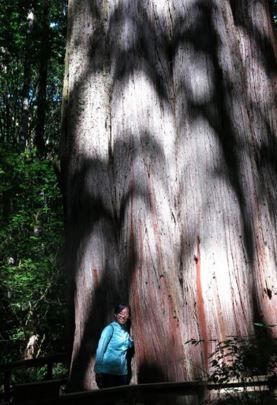
The “Big Tree” Paradise Valley
Cheakamus Centre is located on 420 acres of ecological reserve in the Paradise Valley, in the heart of this groundwater chum salmon reach. This Centre is owned by the North Vancouver School District and gives its students a very real interaction with nature in this unique place intended to instill in young learners a life-long respect and appreciation for the natural world.
Cheakamus Centre also welcomes all those that truly love nature and wish it to be a part of their most memorable experiences. Through nature camps and retreats and more recently weddings surrounded by nature, this unique location calls those who care about such places.
The very name of this place, Cheakamus, is an anglicization version of the Squamish name, Ch'iyákmesh, which means "people of the fish weir”. The Squamish people lived on those lands for untold generations and placed their fish weirs in the various channels of the lower Cheakamus River to harvest the abundant runs of late season chum salmon. Ch'iyákmesh was not only important to the people of the watershed, but the great numbers of chum salmon also nourished a broader community of wildlife during late fall and winter.
The Squamish River Valley and the Cheakamus River have been long recognized as a very important wintering area for bald eagles in western North America. However, during the winter of 1994, Squamish set a new world record count of 3,769 eagles surpassing the previous record count observed on the Chilkat River a decade before. In 1999, the Brackendale Eagles British Columbia Provincial Park, was established in recognition of its importance to eagles. Once again, a unique intersection of geology, biology and human culture makes the Squamish/Cheakamus River, a memorable place indeed.
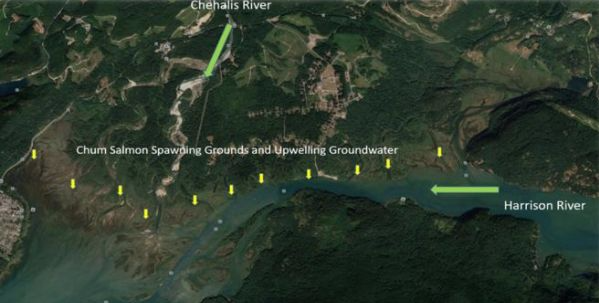
One hundred kilometers further south of the Squamish watershed lies the Harrison River, a large tributary of the lower Fraser River. The Chehalis River, a tributary of the Harrison River, has formed a 7-kilometer wide delta (known as an alluvial fan) at the confluence of the two rivers. The alluvial fan is composed of deep layers of sand, gravel and cobble brought down from the nearby Chehalis River valley and contains a large unconfined aquifer.
This aquifer discharges groundwater all across the lower edge of the 7-kilometer wide alluvial fan as it intersects the Harrison River. Groundwater upwelling occurs along the Harrison River north shore beaches and also discharges into the many old Chehalis River channels that scar the gravel fan. The Chehalis River would flow in one channel for years or decades or centuries and then suddenly break out and cut a new channel, often during a winter flood or when a large log jam formed that denied the river its previous path to the Harrison River. These old abandoned Chehalis River channels known locally as "Sloughs", now receive all their water flows from these aquifer discharges.
The Harrison River, is the premier spawning ground for Fraser River watershed chum salmon. The main spawning occurs in a short 7-kilometer section of the Harrison River and over 50% of the total escapement to the Fraser River and over 2,000,000 chum salmon return to this area in some years.
This area has been occupied for untold generations by the Sta’ailes (Chehalis) people, who continue to this day to have their main village here on the Chehalis River alluvial fan. Due to this rich salmon abundance in this area, this community was unique in that the majority of their salmon fishing occurred in the local area rather than farther upstream in the Fraser River canyon.
The Sts’ailes people recognized four distinct chum salmon runs through the Harrison River. The first run came through the Harrison River early in the fall often in mixed with schools of sockeye salmon. These early fish were silver coloured and did not show the distinct coloured stripes of more mature fish. They were bound for streams that flow into the Harrison Lake, many kilometers upstream from the Sts'ailes main village. While desirable, this run moved very quickly through the Harrison fishing grounds and therefore did not have the same importance to the Sts’ailes as the later runs of chum salmon.
The latest timed and least abundant run of chum salmon were known as "Blackheads" due to the unique dark colouring along their heads and backs. This small run spawned as late as February in very localized groundwater upwellings along the alluvial fans in a few small streams that come down to the Harrison River a few kilometers upstream from the Sts'ailes village. These fish were particularly coveted due to their very late migration timing but their lower abundance meant they did not have the same impact as earlier chum salmon runs.
The last two runs were the back bone of the local fishery, returning from October until January. The late fall spawning "River Dogs" spawned in the main river flows and along the shores of the Harrison River. Wherever the groundwater flowed out of the banks and bed and whenever the rains brought up the level of the Harrison River to allow these large bodied chum salmon full access to these extensive spawning grounds, River Dogs ruled.
Finally, the last but perhaps most important run of chum salmon returned to the many sloughs that ran across the Chehalis River alluvial fan. The chum salmon that ran up into these spawning grounds were known as "Slough Dogs".
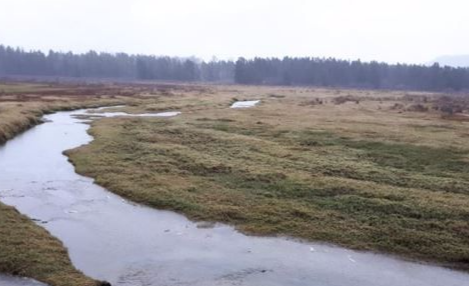
Many of these chum spawning sloughs had permanent longhouses or seasonal pit houses situated near where each slough entered the Harrison River. The various families would occupy these houses during fishing season and selectively harvest chum salmon both in the slough and the nearby Harrison River. The close proximity of their residences to these much- coveted fishing grounds allowed for precise management of fishing times, methods and which salmon were taken and by whom. In more recent times many of the sloughs were given names to honour elders from the fishing families that passed on generational knowledge about these very personal fisheries. Ed Leon, Jimmy Charlie, John Mack, Billy Harris and other sloughs support this very important late season fishery.
In more recent times a number of these sloughs were enhanced to increase the available spawning grounds for chum salmon. Some of the earliest experimental work on groundwater chum salmon enhancement occurred in this area during the 1970’s.
Dave and Rheal, from the newly launched DFO Salmonid Enhancement Program, working together with Chief Bill Williams of the Sts’ailes, created some of the first constructed groundwater salmon spawning channels anywhere around the Pacific Rim.
New projects to restore and enhance the groundwater slough spawning habitats continue today, led by a new generation of biologists such as Kim Charlie and Dave Moore from Sts’ailes Fisheries.
The Harrison Salmon Stronghold Strategic Plan was finalized in 2013, through a community process hosted by Sts’ ailes (http://www.stsailesdevcorp.com/natural-resources/harrison-salmon-stronghold) and was designed to highlight the importance of conserving this unique area. This science based process was supported by groups such as the Pacific Salmon Foundation and the Pacific Fisheries Resource Conservation Council ( https://www.psf.ca/about/pacific-fisheries-resource-conservation-council) and was linked to other regional salmon initiatives promoted through the Wild Salmon Centre (https://www.wildsalmoncenter.org/).
Well managed fisheries, clean gravel beds and abundant upwelling groundwater make the Harrison-Chehalis flats some of the most productive spawning habitat for late chum salmon in the world. Fittingly, on December 18, 2010, a new world record count of 7362 bald eagles was made at the confluence of the Harrison and Chehalis Rivers, reaffirming the magic that the waters of the earth bring to this area.
Homeward Bound
This completes our own migration journey from the Huma River, Heilongjiang Province, China to the Harrison River watershed in southwestern British Columbia, Canada. Untold numbers of watersheds exist across the northern arch of the Pacific Ocean where these stories of chum salmon, people and wildlife are repeated over and over again. Magical, mysterious and simply marvelous, waters from the earth, and the chum salmon that seek out these special places out, have made all these stories possible.
We should take none of these natural wonders for granted, they will all have challenges going forward into an uncertain future. But in this “Year of the Dog Salmon” let us all hope for some good luck and a better future for these beautiful fish.
I will leave the last word on chum salmon to Roderick-Haig-Brown, who has been called the most influential writer on the gentle art of angling since Isaac Walton produced his signature work “The Compleat Angler” in 1653. Both these authors were famous for their poetic and thoughtful insights into angling and what it could teach us all about the natural world and our own life paths
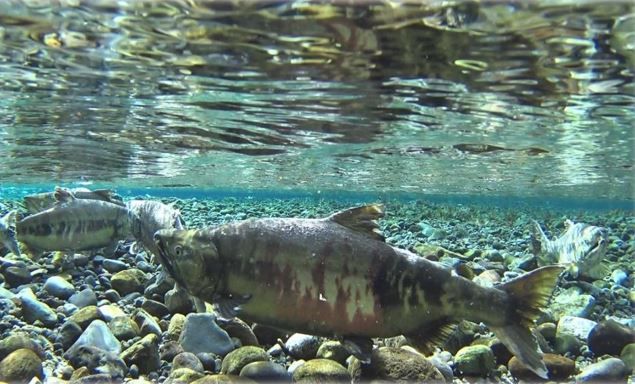
Roderick Haig-Brown left me with a life long appreciation of salmon and the beautiful rivers they inhabit.
From his signature book, A River Never Sleeps, Haig-Brown wrote:
“Dogs are a fine fish …they were a true picture of the abundant wealth of all the salmon.”
ADDRESS
Oweekeno Village
CONTACTS
Email: brydonp@pwhatchery.org
Phone: (604) 449-2040